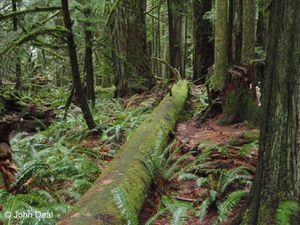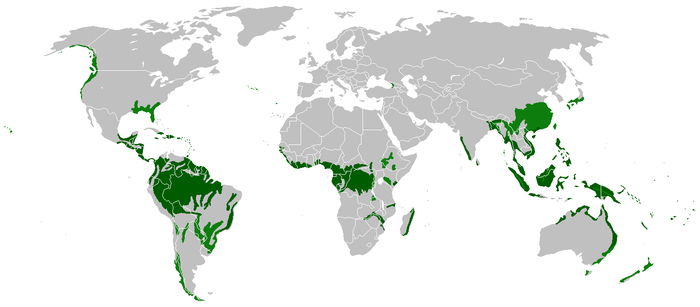Climate change consequences on rainforests: Difference between revisions
(Created page with "asdf") |
No edit summary |
||
| Line 1: | Line 1: | ||
[[Category:Done 2017-07-01]] | |||
[[File:canadas-coastal-rainforest.jpg|300px|thumbnail|Figure 1: British Columbia’s temperate rainforest<ref name = no1/>]] | |||
<onlyinclude>[[Climate change]] has and continues to have a massive impact on Earth’s [[rainforest]]s. Whether it’s North America’s western '''temperate rain forests''' or the '''tropical rainforests''' in South America and beyond, climate change affects these areas negatively.</onlyinclude> Climate scientists in Canada have been monitoring the rainforests over the last few decades to analyze the changes if any, occurring to the west coast. | |||
Rainforests are home to 40-75% of living beings on Earth, they provide over one third of all [[oxygen]] produced and capture massive amounts of [[carbon dioxide]] every year.<ref name = no1>A. Mckinnon et al., “Canada’s Coastal Rainforest,” Hinterland Who’s Who, Ministry of Forests, Government of BC, Fitzhenry and Whiteside Limited, Markham, 2003. Available: http://www.hww.ca/assets/pdfs/factsheets/canadas-coastal-rainforest.pdf</ref> | |||
The most notable changes observed today in rainforests are: | |||
* pest infestations | |||
* increased number of [[forest fire]]s per year | |||
* larger susceptibility to disease | |||
* higher volume of [[invasive species]] | |||
* tree growth pattern changes. | |||
However, these changes are observed differently based on the type of rainforest under observation.<ref>NR.Can (2016, 08, 02). Climate Change [Online]. Available: http://www.nrcan.gc.ca/forests/climate-change/13083</ref> | |||
==Current and Future Impacts to Temperate Rainforests== | |||
In North America, the temperate rainforests have been changing in noticeable ways. These observed changes include deforestation for land use and agriculture, forest fires and species migration. With warming temperatures, drought is a major issue as the humidity in these rainforests is dropping. With this change, species that are well adapted to high moisture will suffer. Marine birds that are native to North America are slowly dying out as invasive species begin to make home in the drying forest and hunt their nests. Future changes to the rainforests are expected to include the conversion of forests to grasslands as the trees adapt to their new changing climate. The consequences on rainforests vary, with some areas begining to have more trees than before and others less so as rain patterns do fluctuate. It is also estimated that forest fire numbers will almost double by the end of the century diminishing massive areas of rainforest.<ref>NR.Can (2016, 07, 18). Impacts [Online]. Available: http://www.nrcan.gc.ca/forests/climate-change/impacts/13095</ref> | |||
==Current and Future Impacts to Tropical Rainforests== | |||
Observed changes to tropical rainforests include fluctuations in rainfall patterns causing slow drying out of the rainforest. In some cases tropical rainforests are expected to have higher storm intensity and, like temperate rainforests, [[species migration]]. Fluctuations in rainfall pattern are the greatest threat to this [[ecosystem]]. For example it has been observed that in the Western Amazon there has been an increase in rain, comparatively the eastern Amazon is showing fewer rainfall events, which is causing drought. Drought can have some major impacts on a rainforests, as they are incredibly important for capturing and storing atmospheric carbon. As the rainforest dries out, the trees will be much more susceptible to fire and disease causing the release of massive amounts of [[carbon dioxide]] back into the [[atmosphere]] thus potentially having an increased [[greenhouse effect]]. This drying of the rainforests will bring about desertification causing a major influence on the ecosystem. Native species will start moving out to more preferable climates becoming an invasive species to their new area.<ref>Rhett Butler, Monga bay (2012, 08, 31). Climate Change Threatens Rainforests [Online]. Available: http://rainforests.mongabay.com/0814c.htm</ref><ref>Rhett Butler, Monga bay (2012, 08, 22). Atmospheric Role of Forests: Rainforests and Climate [Online]. Available: http://rainforests.mongabay.com//0907.htm</ref> | |||
[[File:Rain_forest_location_map.png|700px|center|thumbnail|Figure 2: The world's rainforests, both tropical and temperate.<ref>https://commons.wikimedia.org/wiki/File:Rain_forest_location_map.png</ref> ]] | |||
==References== | |||
{{reflist}} | |||
Revision as of 20:29, 15 August 2017

Climate change has and continues to have a massive impact on Earth’s rainforests. Whether it’s North America’s western temperate rain forests or the tropical rainforests in South America and beyond, climate change affects these areas negatively. Climate scientists in Canada have been monitoring the rainforests over the last few decades to analyze the changes if any, occurring to the west coast. Rainforests are home to 40-75% of living beings on Earth, they provide over one third of all oxygen produced and capture massive amounts of carbon dioxide every year.[1] The most notable changes observed today in rainforests are:
- pest infestations
- increased number of forest fires per year
- larger susceptibility to disease
- higher volume of invasive species
- tree growth pattern changes.
However, these changes are observed differently based on the type of rainforest under observation.[2]
Current and Future Impacts to Temperate Rainforests
In North America, the temperate rainforests have been changing in noticeable ways. These observed changes include deforestation for land use and agriculture, forest fires and species migration. With warming temperatures, drought is a major issue as the humidity in these rainforests is dropping. With this change, species that are well adapted to high moisture will suffer. Marine birds that are native to North America are slowly dying out as invasive species begin to make home in the drying forest and hunt their nests. Future changes to the rainforests are expected to include the conversion of forests to grasslands as the trees adapt to their new changing climate. The consequences on rainforests vary, with some areas begining to have more trees than before and others less so as rain patterns do fluctuate. It is also estimated that forest fire numbers will almost double by the end of the century diminishing massive areas of rainforest.[3]
Current and Future Impacts to Tropical Rainforests
Observed changes to tropical rainforests include fluctuations in rainfall patterns causing slow drying out of the rainforest. In some cases tropical rainforests are expected to have higher storm intensity and, like temperate rainforests, species migration. Fluctuations in rainfall pattern are the greatest threat to this ecosystem. For example it has been observed that in the Western Amazon there has been an increase in rain, comparatively the eastern Amazon is showing fewer rainfall events, which is causing drought. Drought can have some major impacts on a rainforests, as they are incredibly important for capturing and storing atmospheric carbon. As the rainforest dries out, the trees will be much more susceptible to fire and disease causing the release of massive amounts of carbon dioxide back into the atmosphere thus potentially having an increased greenhouse effect. This drying of the rainforests will bring about desertification causing a major influence on the ecosystem. Native species will start moving out to more preferable climates becoming an invasive species to their new area.[4][5]

References
- ↑ 1.0 1.1 A. Mckinnon et al., “Canada’s Coastal Rainforest,” Hinterland Who’s Who, Ministry of Forests, Government of BC, Fitzhenry and Whiteside Limited, Markham, 2003. Available: http://www.hww.ca/assets/pdfs/factsheets/canadas-coastal-rainforest.pdf
- ↑ NR.Can (2016, 08, 02). Climate Change [Online]. Available: http://www.nrcan.gc.ca/forests/climate-change/13083
- ↑ NR.Can (2016, 07, 18). Impacts [Online]. Available: http://www.nrcan.gc.ca/forests/climate-change/impacts/13095
- ↑ Rhett Butler, Monga bay (2012, 08, 31). Climate Change Threatens Rainforests [Online]. Available: http://rainforests.mongabay.com/0814c.htm
- ↑ Rhett Butler, Monga bay (2012, 08, 22). Atmospheric Role of Forests: Rainforests and Climate [Online]. Available: http://rainforests.mongabay.com//0907.htm
- ↑ https://commons.wikimedia.org/wiki/File:Rain_forest_location_map.png

